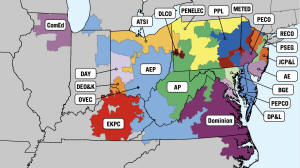Price cap possible as rising energy costs loom
 Send a link to a friend
Send a link to a friend
 [January 29, 2025]
By Christen Smith | The Center Square [January 29, 2025]
By Christen Smith | The Center Square
(The Center Square) – A new deal could dampen the shock of anticipated
price spikes from rising energy costs.
On Tuesday, Pennsylvania Gov. Josh Shapiro said PJM will support a new
price cap meant to lower the cost of the power grid in the coming year
after a recent auction forecasted an 800% increase. That spike would
have translated to a 30% rise in utility bills.
The price cap must receive official approval from the transmission,
generation and distribution companies that supply the grid, as well as
the O.K. from federal regulators.
Sixty-five million people across 13 states, including Pennsylvania and
Washington D.C., rely on PJM to manage the flow of power across the
system minute-by-minute and plan for future electricity needs – like
more power to supply data centers, electric vehicle charging stations,
and energy storage for solar and wind farms.
The organization, however, can only plan within the parameters set by
state and federal governments. That is, thick red tape and tax breaks
meant to incentivize the development of new power producers – as critics
and independent market monitors have warned – appear to have accelerated
the retirement of fossil fuel plants faster than developers can get
renewable replacements up and running.

Those challenges, in part, fueled the dramatic rise in the grid’s
operational costs.
Shapiro said in December that PJM is to blame. In a complaint filed with
the Federal Energy Regulatory Commission, the administration said the
power grid needs to adjust the math used in its auctions and speed up
the approval of new energy projects to prevent a $20.4 billion hit to
consumers.
And as of Tuesday, that request had been taken seriously by the grid's
executive officials. Backed by Democratic governors from four other
states in PJM’s territory, as well as consumer protection organizations,
PJM agreed to submit a price cap adjustment to federal regulators that
would lower the cost from $500 per megawatt day to $325.
“When PJM’s next auction was set to result in historic price hikes, I
filed a lawsuit to stop this price hike on consumers and defend
Pennsylvanians,” Shapiro said. “PJM did the right thing by listening to
my concerns and coming to the table to find a path forward that
will save Pennsylvanians billions of dollars on their electricity bills.
"My administration will continue to work to ensure safe, reliable, and
affordable power for Pennsylvanians for the long term.”
In a statement issued Tuesday, PJM explained more in detail what would
come next, clarifying that the cap isn't finalized. The Federal Energy
Regulatory Commission must sign off on the change, which would require
permission from PJM officials and transmission operators to move forward
with a request.
[to top of second column]
|

A map showing the area PJM Interconnection serves. - PJM
Interconnection

A special meeting to discuss the price cap proposal is scheduled for
Feb. 7, where the organization "can provide further guidance on
implementation of this cap/floor mechanism and discuss associated
tariff revisions."
Beyond the price cap, there’s more change to be done.
Nearly all the planned projects in line for construction are for
renewable resources – think solar, wind and battery storage.
Clearing the backlog is slow, and projects given the go-ahead by PJM
still must overcome permitting challenges and fluctuating supply
chain prices that extend initial construction timelines by years.
As such, PJM has warned that many of the coming replacements won’t
be up and running within the next two or three years, meaning the
cost to support the system in the interim will rise.
It’s a chain reaction for which lawmakers and regulatory agencies
have much greater control, of which PJM is neither.
In Pennsylvania, the “P” in PJM, 25% of the energy necessary to
power the grid is generated. And the tension between renewable
energy investment and fossil fuel power generation has been boiling
over in the commonwealth for years – ever since former Gov. Tom Wolf
signed the state up for the Regional Greenhouse Gas Initiative
without legislative support.
The initiative charges power plants for air pollution and uses the
money collected to support energy efficiency projects. Unlike the
program’s 11 other members, Pennsylvania’s leading role as an energy
exporter and natural gas producer meant penalizing such plants could
cripple one of the state’s most lucrative industries.
In 2023, the Commonwealth Court struck down Wolf’s executive order
as akin to implementing a “carbon tax” without legislative approval,
as required by the state constitution.
Shapiro appealed the decision, promising only to drop it if
lawmakers approved his Pennsylvania-centric version of the program.
The uncertainty hasn’t helped attract investment across the board.
And it ripples out to the rest of the power grid, where other states
have other priorities – like more aggressive renewable energy
targets, the need for more power generation, or both.
 |